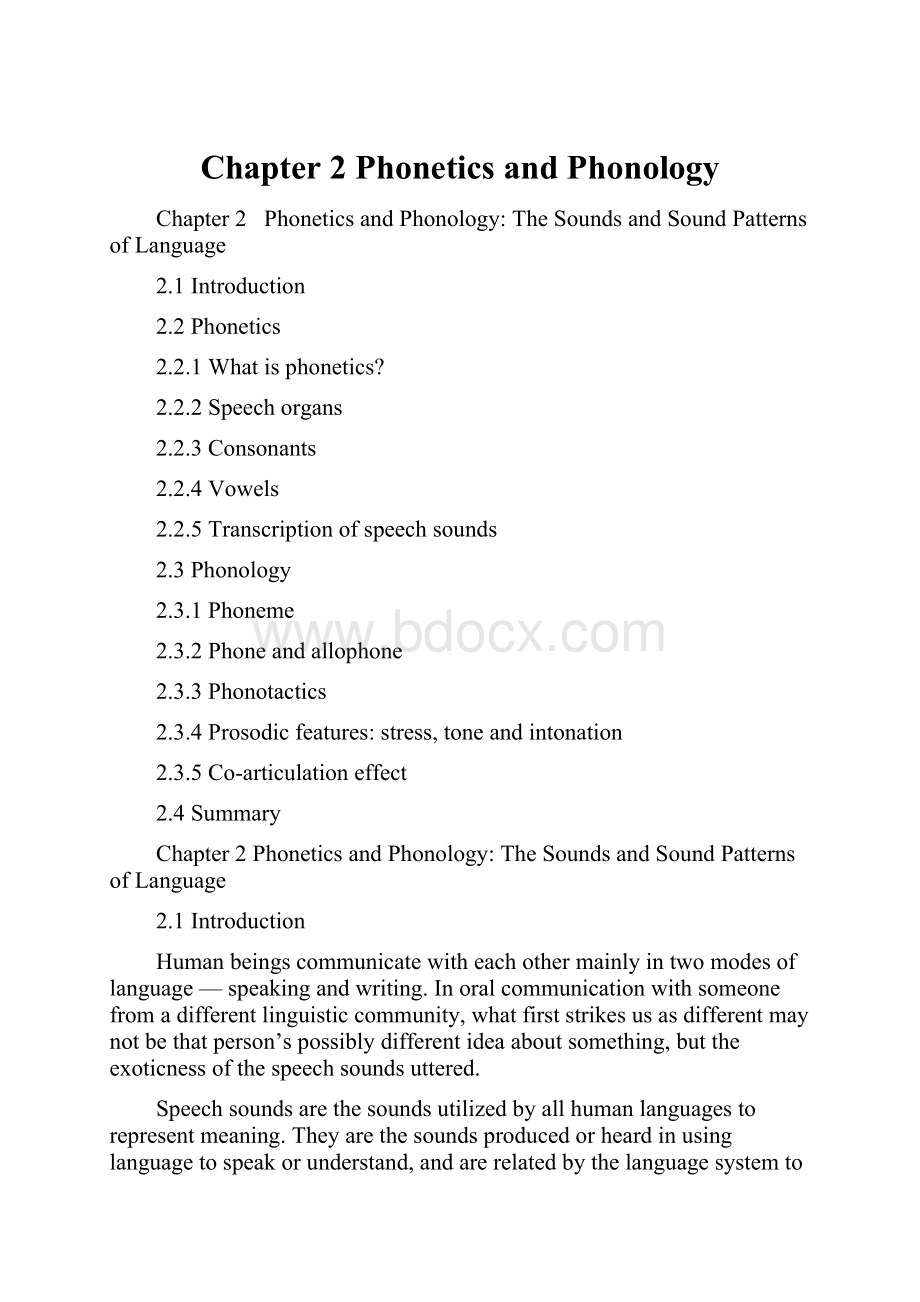 Chapter 2 Phonetics and Phonology.docx
Chapter 2 Phonetics and Phonology.docx
- 文档编号:26545246
- 上传时间:2023-06-20
- 格式:DOCX
- 页数:19
- 大小:60.18KB
Chapter 2 Phonetics and Phonology.docx
《Chapter 2 Phonetics and Phonology.docx》由会员分享,可在线阅读,更多相关《Chapter 2 Phonetics and Phonology.docx(19页珍藏版)》请在冰豆网上搜索。

Chapter2PhoneticsandPhonology
Chapter2PhoneticsandPhonology:
TheSoundsandSoundPatternsofLanguage
2.1Introduction
2.2Phonetics
2.2.1Whatisphonetics?
2.2.2Speechorgans
2.2.3Consonants
2.2.4Vowels
2.2.5Transcriptionofspeechsounds
2.3Phonology
2.3.1Phoneme
2.3.2Phoneandallophone
2.3.3Phonotactics
2.3.4Prosodicfeatures:
stress,toneandintonation
2.3.5Co-articulationeffect
2.4Summary
Chapter2PhoneticsandPhonology:
TheSoundsandSoundPatternsofLanguage
2.1Introduction
Humanbeingscommunicatewitheachothermainlyintwomodesoflanguage—speakingandwriting.Inoralcommunicationwithsomeonefromadifferentlinguisticcommunity,whatfirststrikesusasdifferentmaynotbethatperson’spossiblydifferentideaaboutsomething,buttheexoticnessofthespeechsoundsuttered.
Speechsoundsarethesoundsutilizedbyallhumanlanguagestorepresentmeaning.Theyarethesoundsproducedorheardinusinglanguagetospeakorunderstand,andarerelatedbythelanguagesystemtocertainmeanings.Anyonewhoknowsalanguageknowswhatsoundsareinthelanguageandhowtheyare“strung”togetherandwhatthesedifferentsoundsequencesmean(Fromkin&Rodman,1983:
35).Thestudyofhumanspeechsoundscanbedonebyexaminingthefeaturesofthesoundsperse(Matthews,2001:
33),whichisadoptedbythestudentsofphonetics.Thespeechsoundscanalsobestudiedfromthepointofviewofhowtheyareactuallyusedindifferentlanguages(Katamba,1989:
66),includinghowsomeofthesoundsinterrelateandinteractwitheachotherwithinagivenlanguagesystem,whichisadoptedbythestudentofphonology.
2.2Phonetics
2.2.1Whatisphonetics?
Theterm“phonetics”iscomposedofphone-,whichisfromtheGreekphonêmeaning“sound”or“voice”,and-ics,whichmeans“astudyof”.Sophoneticsisthegeneralstudyofthecharacteristicsofspeechsounds(Yule,2006:
30).Itisconcernedwiththephysicalpropertiesofspeechsounds(phones),andtheprocessesoftheirphysiologicalproduction,auditoryreception,andneurophysiologicalperception.Thus,therearethreebranchesofphonetics.Thestudyofhowspeechsoundsaremadeor‘articulated’iscalledarticulatoryphonetics.Thestudyofhowspeechsoundsareperceivediscalledauditoryphonetics(orperceptualphonetics).Thestudyofthephysicalpropertiesofspeechsoundsiscalledacousticphonetics.Theprimaryconcernofphoneticsisusuallyarticulatoryphonetics.
2.2.2Speechorgans
Thestudyofphoneticshelpsincreaseourawarenessofthepropertiesofspeechsounds,whichinturncanimproveourabilitytoarticulatethemwithaccuracybymanipulatingourspeechorgansmoreappropriately.Thespeechorgansofthehumanbeingsconsistofthreemajorareas:
thepharyngealcavity(thethroat),theoralcavity(themouth)andthenasalcavity(thenose).Thepowersourceofourspeechsoundsistheflowofairfromourlungs,andtheairstreamcomingfromthelungsmaybemodifiedinthecavitiesinvariousways,resultingindifferentkindsofspeechsounds.
palatal
velar
uvula
pharynx
nasalcavity
alveolar
labial
dental
tip
front
back
Larynxincludingvocalcords
Inproducingspeechsounds,westartwiththeairpushedoutofthelungsbythediaphragm,upthroughthetrachea(or“windpipe”)tothelarynx.Insidethelarynxareourvocalfolds(alsocommonlyknownasvocalcords).Whenthevocalfoldsarespreadapart,theairfromthelungspasseswithoutanyrestriction.Soundsthusproducedaredescribedasvoiceless.Contrarily,ifthevocalfoldsaredrawntogether,andtheairfromthelungshastobreakthroughthemrepeatedly,creatingavibrationeffect,thesoundswillbedescribedasvoiced.Youcantellthedistinctionveryeasilybetweenvoicelessandvoicedsoundsbyplacingyourfingertipgentlyonthetipofyour“Adam’sapple”—thepartofthelarynxinyourneckbelowyourchin.Youwillfeelsomevibrationwhenyouproducesoundslike[z],butfeelnovibrationwhenyouproduce[s].
Theoralcavityismadeupofthetongue,theuvular,thesoftpalate(thevelar),thehardpalate(thepalatal),theteethridge(thealveolar),theteeth(thedental)andthelips(thelabial).Ofthesespeechorgans,theveryflexibletongueisofparticularimportance,becausetheprincipalsourceofsoundmodificationisthetongue,somuchsothatthewordforitisoftenusedasasynonymforlanguage(Poole,2000:
42).
Thenasalcavityisapassagewhichisdefinitelyopenorclosed,producingsoundseithernasalizedornon-nasalized.
Allspeechsoundsareproducedbymanipulatingthevocaltractwhileairisflowingthroughit.Ifthismanipulationproducessignificantobstructionoftheairstream,theresultisaconsonant.Ifitdoesnotproduceanyobstruction,theresultisavowel.Thus,speechsoundscanbeclassifiedintoconsonantsandvowelsaccordingtowhethertheairstreamcomingfromthelungsmeetobstructioninproducingthesounds.
2.2.3Consonants
Consonantscanbedescribedaccordingtoplaceofarticulationandmannerofarticulation,thatis,wheretheairstreamismodifiedandhowitismodified.
2.2.3.1Placeofarticulation
Aftertheairstreamcomingfromthelungspassesthroughthelarynx,itcomesupandoutthroughthemouthand/orthenose.Mostofthe24consonantsinEnglishareproducedbyusingthetongueandotherpartsofthemouthtoconstricttheshapeoftheoralcavitythroughwhichtheairispassing(Yule,2006:
30).Inotherwords,theyaremostlyarticulatedviaclosureorobstructioninthevocaltract.Consonantscanbevoicedorvoicelessaccordingtowhetherthevocalcordsvibrateornot.Thefollowingtermsareusedtodescribeconsonantsintermsofwheretheyarearticulated.
A)Bilabials:
Thesearesoundsthatareproducedwiththetwo(bi=two)lips(labia=lips).InEnglish,bilabialconsonantsare[p],[m],[b],and[w].Only[p]isvoiceless,andtheotherthreeareallvoiced.
B)Labiodentals:
Thesearesoundsthatareproducedwiththelowerlipandupperteeth.InEnglish,thereareonlytwolabiodentals:
[f](voiceless)and[v](voiced).
C)Interdentals:
Thesearesoundsthatareproducedwiththetonguebetween(inter=between)theteeth,orjustbehindtheupperteeth(alsocalled“dental”),suchas[](voiceless)inwordslikethinandbath,and[](voiced)inwordslikethereandthen.
D)Alveolars:
Thesearesoundsthatareproducedwiththetonguetipatthealveolarridge,behindtheteeth.InEnglish,thereare7alveolars.Theyare[t],[d],[s],[z],[n],[l]and[r],ofwhich[t]and[s]arevoicelessandtheothersareallvoiced.
E)Palatals:
Thesearesoundsthatareproducedwiththefrontorbodyofthetongueraisedtothepalatalregion.InEnglish,palatalsare[](voiceless)inwordslikeshipandshout,[t](voiceless)inwordslikechildandchina,[](voiced)inwordsliketreasureandpleasure,[d](voiced)inwordslikebridgeandjoke,and[j](voiced)inwordslikeyouandyet.
F)Velars:
Thesearesoundsthatareproducedwiththebackofthetongueraisedtothesoftpalate(alsocalled“velar”).InEnglish,therearethreevelars.Theyare[k](voiceless)inwordslikecoldandkick,[g](voiced)inwordslikegoandbag,and[ŋ](voiced)inwordslikesingandtongue.
G)Glottal:
InEnglish,thereisonlyoneglottal,whichisproducedwithoutactiveuseofthetongueandotherpartsofthemouth.Itis[h](voiceless).Itistermedassuchbecausethesoundisproducedwiththeglottis(thespacebetweenthevocalcords)open.Inotherwords,thereisnomanipulationoftheairpassingoutofthemouth.
2.2.3.2Mannerofarticulation
The24consonantscanalsobedescribedintermsofhowtheyarearticulated,thatis,howtheairstreamismodified.Inproducingconsonants,theairstreamfromthelungsiseithercompletelyblocked(stop),partiallyblocked(lateral)ortheopeningissonarrowthattheairescapeswithaudiblefriction(fricative).Withsomeconsonants(nasals)theairstreamisblockedinthemouthbutallowedtoescapethroughthenose.
A)Stops:
Alsocalledplosives,thesearesoundsproducedbysomeformof‘stopping’oftheairstreamverybrieflythenlettingitgoabruptly.Suchsoundsas[p],[b],[t],[d],[k],and[g]fallintothiscategory.
B)Affricates:
Thesearesoundsproducedbycombiningabriefstoppingoftheairstreamwithanobstructedreleasewhichcausessomefriction.Thetwoconsonants,[t]and[d],areaffricates.
C)Fricatives:
Thesearesoundsproducedbyalmostblockingtheairstreamandlettingtheairforcethroughthenarrowopening.Theyaretermedasfricativesbecausewhentheairispushedthrough,akindoffrictionisproduced.Thefricativeconsonantsare[f],[v],[s],[z],[],[],[θ]and[ð].
D)Nasals:
Thesearesoundsproducedbyallowingairtopassthroughthenosewhileblockedinthemouth.Nasalconsonantsare[m],[n]and[ŋ].
E)Liquids:
Thesearesoundsproducedwithaminimalconstrictionallowingairtopassfreely.[l]and[r]areliquidconsonants.Inproducing[l],theairstreamflowsaroundthesidesofthetongue(itiscalledalateralliquid);andinproducing[r],theairstreamflowsthroughthecenterofthemouth.
F)Glides:
Thesearesoundsproducedwithaminimalconstrictioncorrespondingtoavowel(sometimescalled“semi-vowels”).[w]and[j]aredescribedasglides.Thesound[h],asinhello,canalsobeclassifiedasaglidebecauseofthewayitcombineswithothersounds.
Havingdescribedtheconsonantsintermsofboththeplaceandthemannerofarticulation,wecansummarizethebasicinformationinthechartbelow(-v=voiceless,+v=voiced):
bilabial
labiodental
interdental
alv
- 配套讲稿:
如PPT文件的首页显示word图标,表示该PPT已包含配套word讲稿。双击word图标可打开word文档。
- 特殊限制:
部分文档作品中含有的国旗、国徽等图片,仅作为作品整体效果示例展示,禁止商用。设计者仅对作品中独创性部分享有著作权。
- 关 键 词:
- Chapter Phonetics and Phonology
 冰豆网所有资源均是用户自行上传分享,仅供网友学习交流,未经上传用户书面授权,请勿作他用。
冰豆网所有资源均是用户自行上传分享,仅供网友学习交流,未经上传用户书面授权,请勿作他用。


 《C12343098汽轮机操作规程》要点.docx
《C12343098汽轮机操作规程》要点.docx
